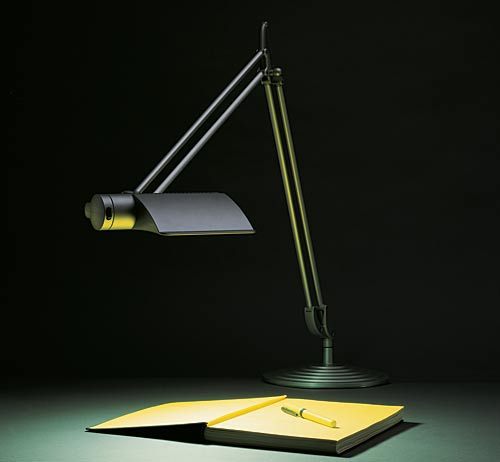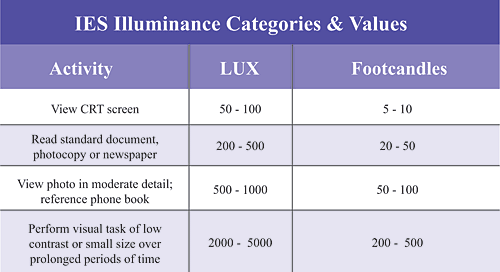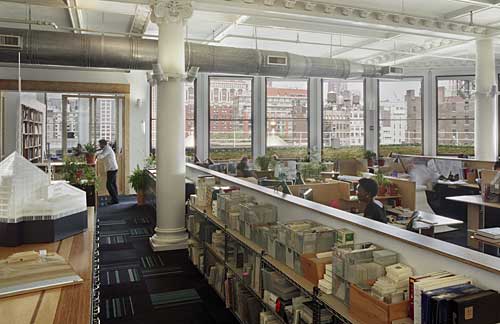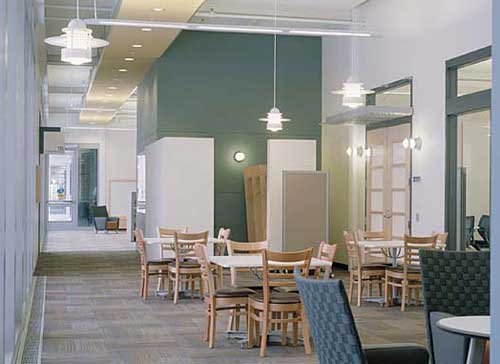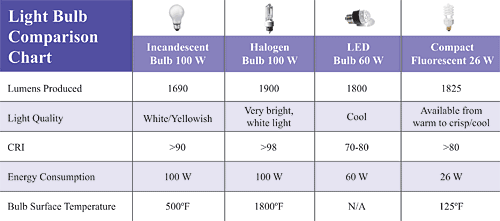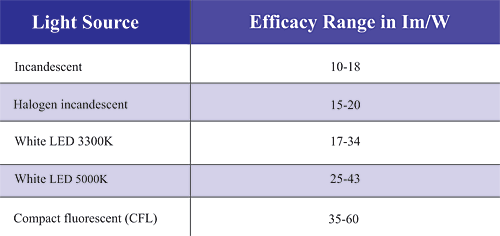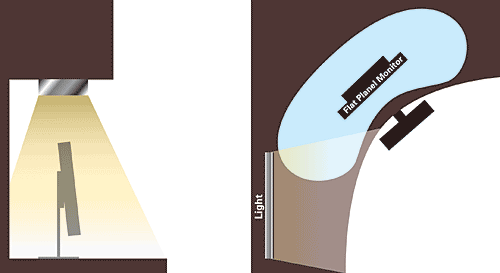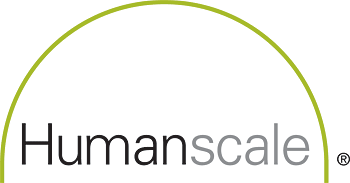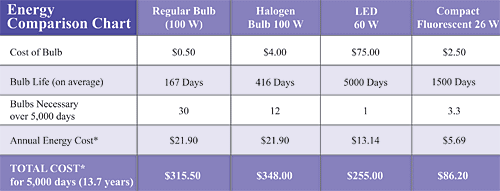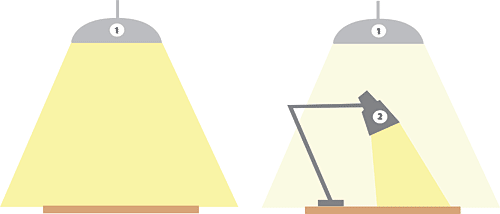Task Lighting Solutions: Their Economic and Ergonomic Benefits
Supported by human factors research and driven by demand for energy savings, task lighting is a critical component of efficient and effective workplace lighting solutions.
![]() Continuing Education
Continuing Education
Use the following learning objectives to focus your study while reading this month’s Continuing Education article.
Learning Objectives - After reading this article, you will be able to:
- Evaluate office lighting design for effective work environments.
- Recognize the importance of incorporating task lighting into an overall lighting plan.
- Identify the environmental, economic and human factor benefits of task lighting.
It was not so many years ago, when employees worked mostly with paper documents, that lighting, like other building systems, was designed around the belief that more is better. Workspaces of the 1960s and 1970s provided more light than the job required with little or no flexibility for the user. The result was wasted energy and a variety of human factors issues, such as eyestrain and headaches. Since then, new human factors research and enhanced technologies have provided designers with smarter solutions. Yet, many offices continue to use dated technology to illuminate workspaces. Moreover, lighting experts report, many designers and consultants pay more attention to the aesthetics of lighting than how it functions for employees.
But as more owners demand energy efficiency or US Green Building Council (USGBC) LEED® certification for their buildings, and a growing number of employers seek productivity measures, the need for functional and efficient office lighting is becoming increasingly critical-as is familiarity with lighting specifications and LEED requirements.
Today's workplace calls for flexible lighting systems that support the tools of the modern office, such as monitors and notebook computers. This suggests the integration of more appropriate lighting solutions into existing lighting plans, and the selection of the most advanced products for new office construction.
Office lighting design continues to move toward greater energy efficiency, while providing improvements for worker comfort and safety. This move toward environmentally responsible design can be further developed with the incorporation of task lighting into workplace lighting schemes that would typically use just ambient or overhead light sources.
One recent example is the USGBC's new headquarters in Washington, DC, which achieved a LEED-Commercial Interiors (CI) Platinum certification. One benefit that accrued outside the recently renovated space, which included individual task lights, was a dramatic reduction in watts-per-square foot. Designers accomplished this by removing excess lighting fixtures, which resulted in energy savings for the building owner.
|
Recent research into the use of task lighting has provided evidence that incorporating positionable light sources into individual workspaces provides many benefits with regard to energy consumption. Additionally, it provides individual workers the freedom to position their light sources most comfortably. Moreover, reports Kate Charles, Ph.D. and Jennifer Veitch, Ph.D. in a presentation at Science Insight 2004, sponsored by the Canadian NRC Institute for Research in Construction, control over physical working conditions contributes to reducing effects of job-related stressors.
In contrast to the assumption that more lighting was better, recent research has shown us that more is not better, and in fact, is not desired by most workers. Providing too much light can lead to the following:
- Energy waste
- Emotional and physical discomfort for the office worker due to improper illumination of the work surface and glare on reflective surfaces (such as the computer monitor)
Using positionable task lighting in addition to low ambient light can lead to the following:
- Improved lighting quality, comfort and control for workers
- Increased energy efficiency
Task lighting can provide illumination where it is most needed-on paper-based documents-more economically than the most energy-efficient ceiling ambient light because task lighting is located closer to what is being lit. In addition, individual workers can gain control over their lighting as appropriate for the task being completed.
Flux, Illuminance and Luminance
Total flux, in lumens, is the parameter that bulb manufacturers use when describing the total amount of light given off by a bulb in all directions. Lumens do not, however, tell us how much light will be received where it is needed. Illuminance, on the other hand, tells us how much light will reach a given surface. Illuminance is generally measured in lux, which is a short form for lumens per square meter of surface area, the metric equivalent of footcandles (which represent lumens per square foot). There are 10.76 lux in one footcandle, but the lighting industry typically rounds this factor to 10.0 for the sake of simplicity.
If we compare a lighting fixture to a shower head, then the lumen output, or total flux, is the rate of flow of water and illuminance is the amount of water collected in a bucket at a given time. The key point is that the same total flux can give different amounts of water in the bucket, simply by moving the bucket, or by changing the spray pattern or by changing any physical obstructions between the source and the bucket. Total flux doesn't specify how much illuminance will be provided where it's needed. This is true, in part, because the luminaire, reflectors, lenses and other optical media can greatly affect the flow of light from the source to the work surface. Failure to remember this is a frequent cause of poor lighting design, especially in retrofit applications.
|
For lighting designs, we should not assume that two lamps with the same lumen rating will each give the same amount of light where needed.
Thirty years ago, standards of the Illuminating Engineers Society of North America (IESNA) called for general office lighting in the range of 100−150 footcandles (1,000−1,500 lux). Huge, increasingly cubicled floorplates, often without any natural, outside illumination, were lighted, for the most part, by banks of 4-ft ceiling-mounted fluorescent troffers (recessed fluorescent fixtures) that, in too many cases, resembled stadium floodlights in their intensity.
|
|
By 2002, nearly all office tasks were being performed on desktop computers and average ambient light levels in the American workplace declined to one-third of 1970s levels. Today, ambient office lighting is likely to be in the range of 25−45 footcandles (250−450 lux), which is still far more light than is necessary for getting around the office or viewing a computer screen. According to IES, computers are best viewed in an environment where the ambient lighting is 5−10 footcandles (50−100 lux), whereas most reading of documents requires 20−50 footcandles (200−500 lux).
The Monitor−Document Conflict
"The demands of differing tasks within the workplace create an obvious conflict in lighting requirements," says researcher Alan Hedge, Ph.D., CPE, Director of the Human Factors and Ergonomics Laboratory at the Cornell University Department of Design and Environmental Analysis. The majority of work that most office workers perform today is a combination of viewing a monitor and reading documents or other printed material. Yet these two tasks require significantly different levels of light because monitors are a source of light whereas paper reflects light. In fact, reading documents requires four to five times the amount of light needed for viewing a monitor.
|
If the ambient lighting level is set at the appropriate level for reading printed documents (20−50 footcandles), the lighting intensity will be much too high for proper monitor viewing (5−10 footcandles required). This leads to glare on the surface of the monitor, substantial energy waste and a variety of worker productivity issues. However, if the ambient lighting level is brought down to a point which is appropriate for monitor viewing and movement throughout the workspace, then there won't be nearly enough light to read documents and other paper-based reading material.
The only solution to this conflict is to lower the overall ambient lighting levels and provide individuals with positionable task lights to properly illuminate the reading material on the desktop. In this way, both the monitor and documents can be lit to appropriate levels for the tasks being performed.
|
Lighting Needs Change As We Age
Equally significant to the fact that different tasks require different amounts of lighting is that actual lighting needs vary among individuals.
The older we get, the more light we need to see. Research indicates that the visual performance of those in their 20s is about eight times better than those in their 60s, almost four times better than those in their 50s. In fact, persons in their 60s require 250 percent more contrast than persons in their 20s.
The increased need for light is due to a number of physiological changes in our visual system, which occur as we age. The term presbyopia means "old eye" and is a vision condition involving the loss of the eye's ability to focus on close objects. An additional symptom is the declining ability of the eye to receive light. Symptoms are usually noticeable by age 45 and continue to develop until the process stabilizes some 10−20 years later.
Eyestrain and accompanying headaches, which can result from working under inadequate illumination, are aggravated by aging. Eye fatigue may result in blurry vision and dim lighting aggravates the problem. Task lighting allows us to achieve the correct levels of illumination, regardless of the task or vision requirements, by changing the distance between the light source and the lit object-closer for more light, further away for less. It also allows us to correctly position the angle of light to eliminate glare and ceiling reflections.
Bulb Options and Energy Effciency
Today's task lights utilize one of four types of lighting: incandescent, halogen, compact fluorescent or light-emitting diode (LED or solid-state lighting), which works by running electricity through a chemical chip, causing the chip to glow. Compact fluorescents burn cooler and have proven to be more energy efficient than any other available task light source. A regular incandescent or halogen bulb works by heating a metal wire to a temperature at which it glows. This requires high temperatures, relatively large amounts of energy, and creates a hot bulb surface. In fact, halogen bulbs can reach temperatures of 1,800 degrees Fahrenheit and have, therefore, been banned from many university dormitories because of their risk as a fire hazard.
A compact fluorescent bulb is a low-pressure mercury, electric- discharge lamp in which phosphor coating transforms ultraviolet energy, created by electric discharge, into visible light. The fluorescent bulb remains much cooler and uses less energy than a regular fluorescent or halogen bulb, while providing the same amount of light.
|
The first practical electric lamp, developed by Thomas Edison in 1879, converted less than one percent of electricity into light. Today's household incandescent bulbs convert 6−7 percent of their electrical input into light. The rest is wasted as heat. Classic 4-ft fluorescent systems convert approximately 19 percent of their energy into light.
Today's compact fluorescent lamps, five inches in length, or less, can be 50 times more efficient than Edison's original lamp and far more efficient than an incandescent light source capable of the same light output. For example, a 13-watt compact fluorescent task light will produce the same light output as a 60-watt incandescent light, burn cooler and consume only one-quarter of the electricity.
|
LED Lighting
The next generation light source to make headlines is solid-state LED lighting. Around since the 1960s, it has only relatively recently been marketed for commercial interiors because of its apparent energy efficiency and other features. Approximately one-quarter-inch in diameter, each diode uses about one-tenth of a watt to operate and can be assembled together to deliver higher intensity light. LED fixtures require a plug-in transformer or a driver-typically built-in-which is comparable to the ballast in fluorescent fixtures. The plug-in transformer used for portable fixtures, enables the lamp to use 120 volt AC.
LED lights are more rugged and damage-resistant than compact fluorescents and incandescent bulbs. They do not flicker, are low maintenance, dimmable and-what makes them especially attractive to those seeking LEED certification-have the potential of low energy consumption. Since they operate at 3300 to 5000 Kelvin (sunlight at sunrise is 1800K, overcast sky is 6500K) they have a "cool" color that ranges from blue to daylight fluorescent.
|
Many designers are now specifying LED lighting because they believe that it is the most energy efficient lighting solution available. Unfortunately, there is much misunderstanding surrounding this new technology. While there are considerable potential advantages to solid-state lighting, the technology is not sufficiently advanced to make it an energy efficient choice at present.
The major cause of misunderstanding results from there being no standard testing criteria. In their product literature, manufacturers use different evaluation criteria to compare their LED products with traditional fluorescent or incandescent lighting. Another difficulty in testing existing LED luminaires is their susceptibility to colorshift and inadequate performance when subject to high heat (some manufacturers have added fans and diffusers to disperse heat.)
After a pilot round of testing several LED products, the U.S. Department of Energy released its conclusions in December 2006. It found that products fell short of manufacturers' claims and implied that claims are based on how much light isolated LED produces rather than how much light an LED fixture actually delivers. The study concluded that "solid-state based luminaires (lighting lamps or fixtures) have the potential to provide high-quality light which consumes far less energy than more traditional lighting technologies, but recent testing of commercially available products show that some being sold today actually provide less light output than traditional light sources and are less efficacious than products using fluorescent light sources."
U.S. Department of Energy testing found that LED bulbs with a temperature of 3300K are about half as energy efficient as standard compact fluorescents (17−34 lumens/watt versus 35−60 lumens/watt for compact fluorescents). Higher temperature LED bulbs (5000K) were somewhat more efficient, but still well below the efficiency of CFLs. Moreover, LED bulbs are not ideal for task lighting because the color is too cool (blue) for most users. In other words, LED products now on the market use more energy and provide less light than their compact fluorescent counterparts.
Meanwhile, researchers are addressing the issue of testing criteria and comparison methods. "We have developed technology-neutral, fixture-based testing methods that allow fixtures of the same type but with different light sources to be compared appropriately," says N. Narendran, Ph.D. of the Lighting Research Center at Rensselaer Polytechnic Institute and director of research and organizer of the Alliance for Solid-State Illumination Systems and Technologies (ASSIST).
|
At some point, perhaps in another two to three years, LEDs will overtake CFLs in efficiency because LED technology is improving. But for now, CFLs are clearly the best solution in terms of energy efficiency.
Task Lighting Saves Eyes
Because they are closer to the work surface, positionable task lights are a considerably more effective means of lighting a desktop than are overhead fixtures, which are costly and inefficient. They can be directed to light documents or moved to avoid screen glare.
"The most common design error, clearly, is the mismatch between where light is being delivered and where people are utilizing that light," says Hedge. "All too often we put light into a building without knowing the ultimate layout. Even if the layout is known, things can happen that are not foreseen. Offices may be partitioned differently by new tenants, for instance, and the new layout can result in a feast or famine situation, so far as light is concerned. Some workers may complain of glare and headaches; some may be in the dark."
In a study conducted in 1990, Cornell researchers drew on an American Society of Interior Designers survey in which 68 percent of employees complained about the light in their offices and 79 percent of VDT users wanted better lighting. The Cornell study came to the conclusion that eyestrain was the number one health hazard in the workplace-ahead of radiation, asbestos, or exposure to AIDS.
Hedge says eyestrain remains the number one complaint in the office environment, and the degree of dissatisfaction is difficult to ignore. It confirms the need to identify the best available methods of lighting. "Combined ambient-task lighting is likely to be the most effective solution in any environment in which workers are doing both paperwork and computer work," says Hedge.
|
|
Task Lighting Saves Energy
A task light using a 26-watt compact fluorescent lamp will consume far less energy to illuminate a work area than will a typical overhead lighting fixture. A work environment can maintain lower levels of overhead lighting by illuminating desktops with energy-efficient task lights. In addition, maintenance and bulb replacement costs are less with task lighting. An Ernest Orlando Lawrence Berkeley National Laboratory 2003 study for the U.S. Department of Energy on Task Ambient Office Lighting concluded that "comparative analyses indicate significant energy and cost savings through separation of ambient and task lighting systems, as high as 60 percent for energy and almost 50 percent for life cycle cost."
|
According to the California Energy Commission, lighting accounts for 23 percent of the electricity used in the state. The actual figure may be considerably higher, say other sources. Five percent of electricity used for air conditioning, for example, goes to eliminate heat generated by lighting. In general, however, the EPA estimates that lighting accounts for 20−25 percent of the electricity used annually in the United States. This suggests that overall energy use can be reduced by more than 10 percent with the introduction of an energy-efficient task-ambient lighting scheme featuring fluorescent technology. One encouraging sign is a recently introduced U.S. Senate bill that proposes a phase-out of incandescent lamps by 2012.
Task Lighting and LEED®
With clients' growing requirements for energy efficiency and the 2,000 percent explosion in USGBC membership, expertise in lighting systems and how they can impact LEED®-CI certification has become a competitive edge.
There are several categories where task lighting can help achieve points. They include:
Indoor Environmental Quality. Providing task lighting for 90 percent of employees may earn a point for controllability of systems.
Materials and Resources. Recycled content of lights and fixtures can contribute significantly to one or two points in the category.
Energy and Atmosphere. Energy use of both ambient and task lighting must be calculated to meet LEED requirements for varying percentages below ASHRAE 90.1−2004 standards (under California's Title 24 Energy Efficiency Standards, the most rigorous in the country, the maximum is one watt per square foot). One challenge in this category is achieving points for a retro fit of an existing building with a traditional overhead fluorescent layout using 1.4 watts per square ft. Designers have solved the problem by removing overhead fixtures and adding low energy task lights, which will ultimately provide a better lighting solution for the occupants.
Francis Rubinstein, Staff Scientist at the Lighting Research Group, Lawrence Berkeley National Laboratory, suggests a different approach: Install overhead lighting that uses one watt per sqare foot, but build in controls and occupant sensors that turn off lights when not in use (a possible gain of one point in the Energy & Atmosphere category).
This will reduce energy use to 0.6 or 0.7 watts per square foot, thereby leaving an energy allowance for task lights.
Innovation and Design Process. This is one LEED category often neglected by designers who are concentrating on reducing energy and water usage. Task lighting, as part of a comprehensive ergonomics program that includes appropriate training for employees, can help a project earn an additional point.
|
||||||||||||||||
The Color of Light
One aspect of lighting that often gets overlooked is bulb color temperature, which describes the color appearance of the bulb, not the object being viewed. Color temperature ranges from 2600 Kelvin for "warm" sources like incandescent lamps, to approximately 6500 Kelvin for "cool" sources like daylight fluorescent. Color temperature data is readily available from lamp manufacturers. The selection of color temperature should be considered relative to the application.
Lamps that are high to very high in color temperature (5000K and above) provide improved visual acuity compared to lower-color temperature lamps (typically 2700K) at the same light level. Visual acuity is generally defined as sharpness of vision, with normal visual acuity rated at 20/20. High color temperature lamps are rich in the blue portion of the color spectrum and have a noticeably "cool" appearance.
The Color Rendering Index (CRI) of a bulb specifies on a scale of 1 to 100 how colored objects appear under that bulb's light compared to their appearance in daylight. A CRI of 100 means no difference, while a low CRI could mean a big difference. Incandescent lamps typically have CRIs above 90, but that doesn't mean that they always give suitable results. Suppose, for example, we wish to illuminate white cabinets in a kitchen or a hospital examination room. A design objective might be to enhance the impression of whiteness, cleanliness and sterility. In this case, the color temperature of incandescents would be too low to achieve the desired effect. As a general rule, one should, therefore, select color temperature first, then select the lamp giving the optimum CRI for the application.
Most fluorescent lamps operate at 3000K to 4100K, with a CRI from the low 50s to 86, but recent technology advancements can produce fluorescents with CRIs above 90.
|
Ballast Technology
All fluorescent lamps require ballasts, which stabilize and control the electrical current that gets sent to the lamp. These ballasts are available in two primary types: magnetic and electronic. While magnetic ballasts use long-standing technology and last for 20 years or more, electronic ballasts have the edge in performance and, because they reduce perceptible flicker, health considerations. Virtually all compact fluorescent lamps specified today use electronic ballasts.
|
Karin Tetlow writes frequently about architecture and construction.

